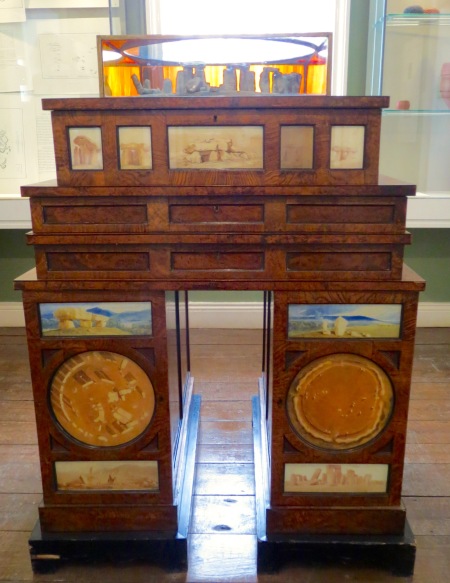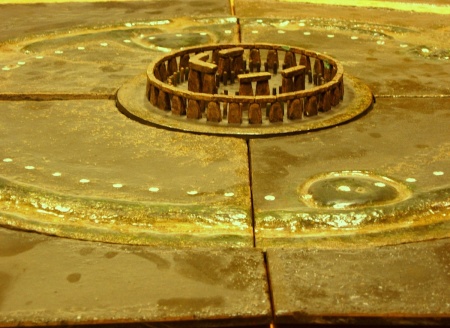
The famous Britton “Celtic” Cabinet at the Wiltshire Museum in Devizes
Greetings and a very happy solstice to all of you out there in the increasingly strange world of now! We know that people generally don’t find time to read blog posts anymore, what with one apocalypse or another looming at any given moment, but in a contrary spirit we have decided to write a longer one than usual. But with pictures, so there’s that!
As some of you may know, a little over a year ago, the entire staff of the Clonehenge blog flew over the sea to the centre of henging contagion, that hulking grey pile of construction debris on Salisbury Plain, Stonehenge itself. We posted in October about the unabashed promotion of Stonehenge replicas we discovered at the shop in the Stonehenge Visitor Centre, but we have yet to share our other extraordinary encounters with replicas shown us by friends of the Clonehenge blog in the area.
The first of these was a huge concrete trilithon, currently being stored at the farm of Mr. Tim Daw whose name may be familiar to Stonehenge fans as a result of theories and discoveries he made while employed at Stonehenge. He is also known for his remarkable construction, the Long Barrow at Al Cannings. He kindly treated us to a tour of that beautiful modern long barrow, and then, knowing our interests, led us through chalk mud, a remarkably clingy substance, to the three pieces of the trilithon, currently not set up as a trilithon but in repose. The two uprights, we are told, weigh 40 Tonnes each and the lintel 10 and a half!

concrete trilithon in the Vale of Pewsy (the markings are not tribal, 😉 but were painted there for visibility on the lorry journey to where they now rest)
These “stones” were used in the 1996 BBC documentary Secrets of Lost Empires: Stonehenge to to represent the stones of Stonehenge’s largest trilithon, in an attempt to demonstrate how those and the other large stones at Stonehenge may have been moved. We assume their length includes the section that in the original stones extended underground to keep them steady and upright. Pictures on this page show their size better than our poor picture above. They are imposing in person, even lying down. Mr. Daw and others are hoping to use them again to test various Stone-Age-appropriate methods for transporting and erecting megaliths, for a programme on how Stonehenge may have been constructed. We look forward to that!
For the next couple days of our trip, we enjoyed the wonders of Wiltshire, its landscape, and many ancient stones and sites (including Stonehenge in the pouring rain, a quintessentially British experience not to be missed unless you have the opportunity to see it in any other weather!). Those days were overwhelmingly beautiful and fascinating, and we extend our thanks to many people for going out of their ways to make it so.

West Kennet Long Barrow with Terence Meaden, who was kind enough to accompany us there and share his knowledge
And then, on our final day in that county, probably still bearing chalk mud in the treads of our shoes, we visited the Wiltshire Museum in the town of Devizes in the company of long-time friend of the blog Pete Glastonbury. There, to our astonishment, we were greeted by people who already knew of the name of Clonehenge, and who were therefore willing to reveal to us deeply secret Stonehenge models hidden from the prying eyes of the general public! (Or, yes, possibly just Stonehenge models that would be of absolutely no interest to anyone one but us, but let us have our fantasies.)
After a few minutes surveying small Stonehenge models available in the museum shop, we were introduced to none other than Director David Dawson and led upstairs to view the wonderful Britton Cabinet whose picture adorns the top of this post. We posted about it on this blog years ago, with photos by Mr. Glastonbury, but it was another thing to see it in person! If we described it in detail, this post would be insufferably long (like it is already, only more so), but as it says on this page, “Integral to the design of the cabinet are three models of Stonehenge and Avebury made by Henry Browne.” We are not ashamed to say that we were moved to see in person some of the historical Stonehenge models made by Mr. Henry Browne himself. Browne’s models were, as far as we can tell, the first Stonehenge models to become popular enough to create a demand. The sale of small Stonehenges that we see today in such profusion probably started with him!
A drawer of the cabinet was opened for us, and protective covering carefully lifted from a model so that we might see it. Unlike the model under coloured glass atop the cabinet, which is meant to show the monument as it now stands, this one represents Stonehenge as it is thought to have looked before the destructive forces of time acted upon it.

in the drawer, a Henry Browne model

model of Avebury in a drawer of the cabinet, overseen by Pete Glastonbury
When we had finished looking at and photographing the cabinet and its contents, Mr. Dawson then kindly brought out two more Stonehenge models: a resin one made by Michael Postins, who made the ‘template’ for models sold by English Heritage for tourists,

resin model by Michael Postins, here held by Director Dawson
and a smaller metal one with various military badges, a bit eccentric, which, of course, appeals to us. No history is known for this, but it’s a nice portrayal with stones that look a bit organic, as if they were about to come to life.

There is much more to the museum, of course, including fascinating and beautiful artefacts from Wiltshire, some found at and near Stonehenge and thought to have belonged to the ancient people who built it and celebrated there. If you’re visiting Stonehenge and want more of its story, you should make a point to stop at the Wiltshire Museum.
We had many more adventures worth telling, and saw more Stonehenge and Avebury models on our trip. But solstice awaits, and the long journey toward shorter days. If you have read this far, we thank you for your time. There truly is a wonderful world of Stonehenge replicas out there, and wonderful people who make them or are fascinated by them. Until next time, friends, happy henging!



























